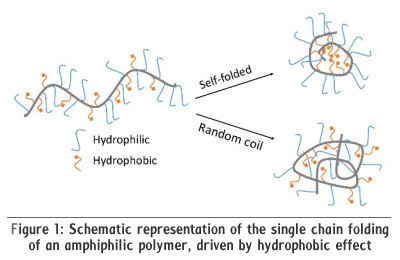
Contacts:
Supervisor(s):
Prof. G. Galli - Dr. E. Martinelli
Title of the PhD project:
Functional materials containing single-chain folding polymers
Abstract of the PhD project:
Background
Copolymers self-assembly is a convenient way to establish nanoscale organized structures. Block copolymer can self-organize in a great variety of tunable and predictable morphologies. These are function of molecular parameters such as molecular weight, polydispersity, block length and chemical heterogeneity of components1. Controlled radical polymerization techniques allow the synthesis of a wide range of polymeric materials with those features in a relatively easy fashion.
In polymer science it is generally assumed that the properties of a material are defined by the collective behaviour of several macromolecules, both in bulk and solution, through intermolecular interactions. Recently the opportunity to generate nanomaterials through folding a single polymeric chain arises a major interest2. This phenomenon is due to intramolecular interaction. This concept has clear biomimetic origins. In protein folding, a specific aminoacidic sequence induces a precise three-dimensional structure, responsible for specific functions of the unimolecular object.
To induce folding in non-natural polymers a number of intramolecular interactions common in supramolecular chemistry can be exploited: hydrophobic effects, H-bonding, π-stacking, molecular recognition, host-guest chemistry and metal-ligand complexation. Unimolecular engineering makes extensive use of these isotropic interactions to collapse random coil macromolecules in more ordered globular entities.
Developing a single chain folding device, as an alternative for common collective aggregates, is beneficial in terms of atom economy and size reduction, both crucial in present nanotechnologies. Single chain folding polymers can advance a number of possible applications3 as unimolecular objects like in catalysis, drug transport and release or can be used to functionalize substrates, for instance in microelectronics. Moreover, without covalent crosslinking, these particles undergo reversible folding and maintain a tunable, stimuli responsive character. Nevertheless, chemical heterogeneity is critical for material interacting with biological media, like in protein adsorption or cell growth that rely on interactions sensitive to variations in few a nanometre scale.
Project overview
In this work, we will synthesize amphiphilic copolymers via controlled radical polymerization. The chemical incompatibility between components (such as hydrophilic PEGylated monomers and hydrophobic fluorinated or siloxanes ones) causes strong segregation and migration both in bulk and solution, producing ordered nano- and microstructures. We hypothesize that this kind of copolymers, in a suitable environment, can form single chain folded micelles4, with a collapsed morphology, containing a hydrophobic compartment (Figure 1).
After copolymer characterization, solution aggregates will be studied by scattering techniques (light and neutrons), isothermal titration calorimetry, and surface tension measurements. The chemical structure of copolymers design will allow their use in nanostructured film, with controlled wettability characterized first by contact angle measurement and x-ray photoelectron spectroscopy. Then they will be exploited in the development of innovative, non-toxic, biocompatible polymeric coatings, with controlled biofouling adhesion and fouling release properties, owing to their chemically and morphologically ambiguous surface5.
References
(1) Kim, H.-C.; Park, S.-M.; Hinsberg, W. D. Chem. Rev. 2010, 110, 146–177.
(2) Ouchi, M.; Badi, N.; Lutz, J.; Sawamoto, M. Nat. Chem. 2011, 3, 917–924.
(3) Lutz, J.-F.; Ouchi, M.; Liu, D. R.; Sawamoto, M. Science 2013, 341, 1238149.
(4) Terashima, T.; Sugita, T.; Fukae, K.; Sawamoto, M. Macromolecules 2014, 47, 589–600.
(5) Martinelli, E.; Sarvothaman, M. K.; Galli, G.; Pettitt, M. E.; Callow, M. E.; Callow, J. A.; Conlan, S. L.; Clare, A. S.; Sugiharto, A. B.; Davies, C.; Williams, D. Biofouling 2012, 28, 571–582.
Publications:
● Martinelli E., Guazzelli E., Bartoli, C., Gazzarri M., Chiellini F., Galli G., Callow M.E., Callow J.A., Finlay J.A., Hill S., Amphiphilic Pentablock Copolymers and Their Blends with PDMS for Anti-biofouling Coatings, J. Polym. Sci. A Polym. Chem., 2015, 53, 1213–1225
External courses and schools:
● Polymers at interphases and surfaces. Gargnano EPF 7th summer school 17/05/2015-22/05/2015
Participation in national and international conferences (poster, oral, invited):
● European Polymer Federation 2015 congress, Dresden 21-26/06/2015
● Presented posters:
1. (EPF 7th summer school Gargnano Polymers at interphases and surfaces): Amphiphilic pentablock copolymers and their blends with PDMS for biofouling-release coatings, E. Guazzelli, E. Martinelli, C. Bartoli, M. Gazzarri, F. Chiellini, G. Galli, M.E. Callow, J.A. Callow, J.A. Finlay, S. Hill
2. (EPF2015 congress Dresden): Polysiloxane, polyethylene glycol and polyperfluoroacrylate pentablock copolymers for anti-biofouling coatings, E. Guazzelli, E. Martinelli, C. Bartoli, M. Gazzarri, F. Chiellini, G. Galli, M.E. Callow, J.A. Callow, J.A. Finlay, S. Hill

